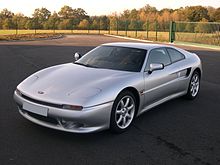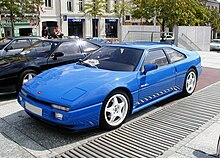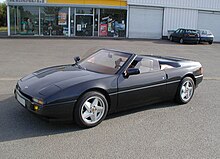Venturi (company): Difference between revisions
m Filling in 4 references using Reflinks |
Cyberbot II (talk | contribs) Rescuing 1 sources, flagging 0 as dead, and archiving 0 sources. #IABot |
||
| Line 45: | Line 45: | ||
[[Image:Stand Venturi Mondial 2006.jpg|thumb|right|250px|[[Venturi Fétish]] in a showroom]] |
[[Image:Stand Venturi Mondial 2006.jpg|thumb|right|250px|[[Venturi Fétish]] in a showroom]] |
||
In 2001, the [[Monaco|Monegasque]] millionaire [[Gildo Pallanca Pastor]] bought Venturi and decided to focus on electric-powered engines,<ref>[http://business.blogs.cnn.com/2012/10/16/electrifying-ideas-to-give-monaco-a-new-spark/ ]{{ |
In 2001, the [[Monaco|Monegasque]] millionaire [[Gildo Pallanca Pastor]] bought Venturi and decided to focus on electric-powered engines,<ref>[http://business.blogs.cnn.com/2012/10/16/electrifying-ideas-to-give-monaco-a-new-spark/ ] {{wayback|url=http://business.blogs.cnn.com/2012/10/16/electrifying-ideas-to-give-monaco-a-new-spark/ |date=20121017115946 }}</ref> leading to the [[Venturi Fétish|Fétish]] model. More recent models are the [[Venturi Eclectic|Eclectic]], the world's first energy-autonomous vehicle, a low speed vehicle that has solar panels and a built-in wind charger and can be plugged in and the [[Venturi Astrolab|Astrolab]], the world's first solar-electric hybrid car. There have been approximately 60-65 orders for the Fétish, but only about 30 have been delivered as of 2011. |
||
== List of models == |
== List of models == |
||
Revision as of 07:09, 13 February 2016
| File:Venturi logo.png | |
| Company type | Private |
|---|---|
| Industry | Automotive |
| Founded | 1984 |
| Founder | Claude Poiraud Gérard Godfroy |
| Headquarters | |
Key people | Gildo Pallanca Pastor, (CEO & Chairmen) |
| Owner | Gildo Pallanca Pastor (100%) |
Number of employees | 140 (2012 est.)[1][2][3] |
| Divisions | Venturi North America |
| Subsidiaries | Voxan (100%) |
| Website | http://www.venturi.fr/ |
Venturi Automobiles is a French-founded Monegasque-based multinational automotive manufacturer that designs, manufactures, and sells luxury electric vehicles. Founded in 1984 by engineers Claude Poiraud and Gérard Godfroy as MVS (Manufacture de Voitures de Sport), the company's purpose was to compete in the "Grand Tourisme" market. This was only the most recent post-war attempt at building a sporty luxury car in France, following in the footsteps of Facel Vega, Monica, and Ligier.[4] As for its predecessors, Venturi was immediately faced with many challenges ranging from an unknown name to its under-capitalized and under-staffed state. Venturi did nonetheless manage to continue in production for nearly sixteen years, declaring bankruptcy in 2000 In 2001, Monegasque Gildo Pallanca Pastor purchased Venturi, and decided to focus on electric-powered engines. This change of direction led to the limited-production Fétish.
In December 2009, Venturi announced its acquisition of French motorcycle manufacturer Voxan. The acquisition would effectively allow Venturi to enter the motorcycle market. In August 2011, Venturi announced the creation of Venturi North America, based in Columbus, Ohio. Venturi North America was primarily created as a research and development center, and as such, maintains a close working relationship with the Center for Automotive Research.
History

The first Venturi came out in 1984, created by Claude Poiraud and Gérard Godfroy, two former engineers at Heuliez. The goal was to present the only "Grand Tourisme" French car capable of competing with the English Aston Martin, the Italian Ferrari, and the German Porsche. The first car shown had a Volkswagen Golf GTi engine and the name was originally spelled "Ventury", with a "y" at the end. In 1985, the car was shown with a 200 PS (147 kW) Peugeot 505 Turbo engine, but by the 1986 Paris Motor Show it had reached its definitive form with the PRV V6 engine. Production began in 1987, with five cars built in the first year. The headquarters of the company were located in Couëron, Pays de Loire, where almost 750 cars were produced in 20 years.

From 1987 to the mid-1990s, they built mid-engined coupés and roadsters with turbocharged PRV engines and Renault gearboxes. Engine power ranged from 160 to 260 PS (118 to 191 kW) for the MVS Venturi Coupé and Transcup series.
A limited-edition 400 GTR was built for racing homologation requirements and later used in the 24 Hours of Le Mans. Venturi was also briefly involved with the Larrousse Formula One team. The team's 1992 car, which bore the Venturi name, was designed and built by Venturi Larousse UK, a British company formerly known as Fomet 1, which had previously designed the 1991 Fondmetal Formula One cars.[5] The 400 GT remains one of the best performing French cars ever produced, and it is in fact the very first car in the world to have standard carbon brakes.[6] True to that claim, the Atlantique 400 GT with a 408 PS (300 kW; 402 hp) V6 3.0 24v DOHC twin-turbo delivered excellent performance to put it on par with Ferraris of the early 90s. The 400 GT could hit 100 km/h (62 mph) in 4.7 seconds and 291 km/h (181 mph) top speed, while the Atlantique 300 biturbo with a 314 PS (231 kW) V6 did 4.9 seconds to 100 km/h (62 mph) and went all the way to 171 mph (275 km/h).

High-level competition has also brought fame to the brand. Stéphane Ratel, who would later found the FIA GT Championship, was at the origin of the Venturi Gentlemen Drivers Trophy, which gathered an impressive array of 75 drivers. Venturi has also won fame through its brilliant performances in the 24 Hours of Le Mans, particularly in 1993 with Christophe Dechavanne and Jacques Laffite on Venturi Jaccadi team, and in 1995 with Paul Belmondo racing on the 600 SLM.
However, it is in the BPR Global GT Series races that Venturi established its pedigree defeating Porsche and Ferrari on several occasions. In 1994 in Dijon-Prenois, with Ferté and Neugarten on the 600 LM Jaccadi, at the 1000 km of Paris with Henri Pescarolo and Jean-Claude Basso on the 600 LM, and finally at the 4 Hours Spa race, once again with Michel Ferté and Michel Neugarten.
Revival

In 2001, the Monegasque millionaire Gildo Pallanca Pastor bought Venturi and decided to focus on electric-powered engines,[7] leading to the Fétish model. More recent models are the Eclectic, the world's first energy-autonomous vehicle, a low speed vehicle that has solar panels and a built-in wind charger and can be plugged in and the Astrolab, the world's first solar-electric hybrid car. There have been approximately 60-65 orders for the Fétish, but only about 30 have been delivered as of 2011.
List of models
- MVS Venturi (includes Coupé and Cabriolet versions)
- 1987-1990 – Coupé 160 automatic, Transcup, Transcup automatic (six built)
- 1987-1990 – Coupé 200, Transcup
- 1991 – Coupé 210, Transcup
- 1992 – Coupé 180, Transcup (export model, mainly for Italy)
- 1989-1996 – Coupé 260, Transcup (sold as the MVS 2.80 in 1989)
- 1991 – 260 Atlantique
- 1994-1996 – 260 LM
- Trophy - 73 built for racing, ten later converted for street use by the factory[6]
- 1994-1997 – 400 GT (15 built, 13 series 1 and two series 2)[6]
- Venturi Atlantique (rework of the MVS Venturi)
- 1996-1998 – Atlantique 300
- 1999-2000 – Atlantique 300 Biturbo
- 1999 – 300 GTR
- 500 LM
- 600 LM
- 600 SLM
- Fétish
- GT3
- Eclectic (concept car)
- Astrolab (electro-solar concept car)
- Volage[8][9] (electric concept roadster car with 8 Active Wheel in-wheel motors from French tire giant Michelin) [10]
- Eclectic 2.0
- La Jamais Contente
- Fétish II next generation of the Fétish
- America concept SUV
Complete Formula One results
(key) (results in bold indicate pole position)
| Year | Entrant | Engine(s) | Tyres | Drivers | 1 | 2 | 3 | 4 | 5 | 6 | 7 | 8 | 9 | 10 | 11 | 12 | 13 | 14 | 15 | 16 | Points | WCC |
|---|---|---|---|---|---|---|---|---|---|---|---|---|---|---|---|---|---|---|---|---|---|---|
| 1992 | Central Park Venturi Larrousse | Lamborghini V12 | G | RSA | MEX | BRA | ESP | SMR | MON | CAN | FRA | GBR | GER | HUN | BEL | ITA | POR | JPN | AUS | 1 | 11th | |
| Bertrand Gachot | Ret | 11 | Ret | Ret | Ret | 6 | DSQ | Ret | Ret | 14 | Ret | 18 | Ret | Ret | Ret | Ret | ||||||
| Ukyo Katayama | 12 | 12 | 9 | DNQ | Ret | DNPQ | Ret | Ret | Ret | Ret | Ret | 17 | 9 | Ret | 11 | Ret |
References
- ^ Posted: April 14, 2011 (2011-04-14). "French Electric Vehicle Maker Parks New Location Near CAR | COLLEGE OF ENGINEERING". Engineering.osu.edu. Retrieved 2016-01-23.
{{cite web}}: CS1 maint: numeric names: authors list (link) - ^ http://www.bizjournals.com/columbus/news/2011/01/14/venturi-foresees-its-electric-cars.html?page=all
- ^ [1][dead link]
- ^ Decker, Jean-Paul (July 2014). "Requiem pour un nom". Rétroviseur (in French) (302). Fontainebleu, France: Éditions LVA: 70. ISSN 0992-5007.
{{cite journal}}: Unknown parameter|trans_title=ignored (|trans-title=suggested) (help) - ^ Henry, Alan (1992). Autocourse: the World's Leading Grand Prix Annual 1992-93. Motorbooks Intl. p. 83. ISBN 0-905138-96-1.
- ^ a b c Liszewski, Nicolas (2004-12-23). "Guide d'achat: Venturi 400-GT" (in French). l'Automobile Sportive.
{{cite web}}: Unknown parameter|trans_title=ignored (|trans-title=suggested) (help) - ^ [2] Archived 2012-10-17 at the Wayback Machine
- ^ "Paris Motor Show 2008". Venturi.fr. Archived from the original on December 21, 2008. Retrieved 2009-04-29.
{{cite web}}: Unknown parameter|deadurl=ignored (|url-status=suggested) (help) - ^ Wojdyla, Ben, (2008-10-03). Venturi Volage Concept Debuts At Paris Auto Show, Sets Standard For Electric Car Wackiness. Retrieved 2008-10-03.
- ^ Rubens, Craig (2008-10-08). "9 Sexiest Electric Cars from the Paris Auto Show". Earth2tech.com. Retrieved 2009-04-29.
External links
Officials
Others
- Venturi Astrolab solar car, see also [3].
- Automotive companies of France
- Motor vehicle manufacturers of France
- Car manufacturers of France
- Sports car manufacturers
- Companies of France
- Automotive companies of Monaco
- Motor vehicle manufacturers of Monaco
- Car manufacturers of Monaco
- Companies of Monaco
- Companies established in 1984
- Solar car racing
- Electric vehicle manufacturers
- Brands of Monaco
